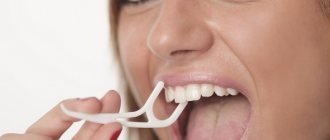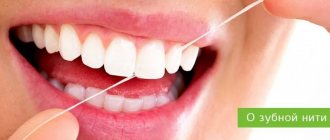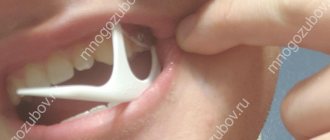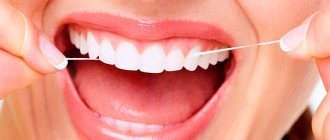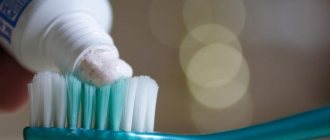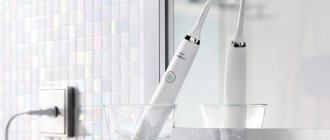1519
Wearing braces requires more care than usual. For this, many special devices are used, among which dental floss (floss) plays the main role.
To clean braces, it is recommended to use special threads intended only for orthodontic structures . This is one of the means that will allow for high-quality cleaning of the dentition in almost any situation.
Cleaning Basics
It is important to follow the instructions for use of the hygiene product in order to clean correctly with subsequent maximum effect.
Preparation
After eating, if you have braces, you should rinse your mouth and brush your teeth with a regular toothbrush. You can use a special toothbrush, however, it will not completely remove all food particles. Therefore, you should start working with dental floss, which has a second name - floss.
Cleaning instructions
Cleaning teeth with braces using floss is carried out in the following sequence:
- First, you should prepare the floss itself - only 20 cm will be enough to clean one tooth. The ends of the piece are wrapped around your thumbs, leaving a distance of 2-3 cm.
- It is recommended to start the procedure from the top row. To do this, a thread stretched with your fingers should be inserted under the metal arch of the braces, and then make zigzag movements towards the teeth - first moving up and then down. During movements, you should carefully touch the gums, but do not make sudden movements, as this can significantly damage the soft tissue.
- As soon as the interdental spaces are cleared , you should begin to remove plaque from the surface. To do this, floss is placed behind the tooth, and then it is wrapped around it to capture the back and side parts at once. Move up and down using the gums in the same way.
- After treating all the teeth , you need to start cleaning the bracket system itself. Its cleaning is carried out in the same sequence, only the floss introduced under the arc should be moved from one base to another. When cleaning, it is important to wipe the surface of the arc itself. After cleaning one segment, the thread is changed and moved on to the next.
- Once the top row of teeth is cleaned , you can move on to the bottom row. The index fingers are already used for pulling.
This is important: To achieve better cleansing, you need to change the pieces of floss each time. You cannot use one floss to clean several teeth, because after the first floss a huge amount of bacteria accumulates on it and is transferred from place to place. As a result, you can provoke destruction of the surface, which will be noticeable after the braces are removed.
Step-by-step instructions for using dental floss
Features in cleaning
The features and recommendations for brushing teeth with the designs presented by the hygiene product should be listed:
- It is better to carry out the procedure in front of a mirror;
- during preparation, it is recommended to use not a simple toothbrush, but a special orthodontic one with short bristles;
- when introducing floss under the arch, you should be careful, since if a snag occurs, the integrity of the system can be damaged;
- It is recommended to purchase a special puller for dental floss so as not to damage the structure;
- Do not press hard on the surface of the tooth while brushing, so as not to cause damage to the enamel;
- Parents should supervise their child's teeth brushing.
Often, after the first procedure, a person develops slight bleeding of the gums. In this case, there is no need to worry, it is enough to continue to be careful so that this does not happen again in the future.
Bleeding often develops due to sensitivity of the gums, which will also go away over time.
How and with what to properly clean braces and teeth
Once the braces are in place, a regular toothbrush won't help much. The presence of an arc or rubber bands will not allow you to remove plaque from all places on your teeth. In the first days after getting braces, teeth may hurt, and many patients may be tempted to “feel sorry for themselves” and not brush their teeth. Your teeth will stop hurting, but it will be difficult to remove leftover food. It is important to avoid such thoughts and carry out hygiene procedures in any case.
V-shaped orthodontic brush
An orthodontic V-shaped brush differs from a regular brush by having a strip of short bristles in the middle. This strip of short bristles creates a groove at the level of the part of the tooth to which the bracket will be attached, following the shape of the surface. The presence of such a gutter makes cleaning easier and improves its quality. When brushing your teeth, you should make vibrating circular movements, spending at least 10 seconds on one tooth . If you look at the end of such a brush, the outline of the bristles will be shaped like the letter V, which is why it got its name.
Mono-beam brush
A mono-beam brush is not much like a regular one. Bristles collected in one bunch are attached to the rounded working part. The use of this brush is of an auxiliary nature. This brush is designed to remove plaque from hard-to-reach places . Its dimensions allow you to remove plaque from under the arch and clean the area of the tooth located next to the braces. The movements made by the brush should look like sweeping. Light pressure on the brush is acceptable. In this case, the bristles are spread out like a fan over the surface of the tooth and help cover a large area of its surface.
Orthodontic brushes for cleaning braces
Orthodontic brushes are designed to clean inaccessible areas, such as wide interdental spaces, as well as areas under the arch of the bracket system. Interdental spaces occupy 1/3 of the entire tooth area. It is this part of the tooth that especially suffers from lack of hygiene when wearing braces. It is brushes that can efficiently clean these tooth surfaces. If your teeth are closely spaced, then you should give preference to another method of cleaning this area, for example, dental floss.
Dental floss for cleaning braces (floss or super-floss)
Dental floss is designed to clean the areas between teeth. To clean teeth with braces, regular dental floss can only be used in conjunction with thread guides, similar to ultra-thin fishing line. The thread guide will allow you to guide the dental floss under the braces.
A loop is made from the thread guide and inserted into the interdental space. Dental floss is threaded through this loop and brought out between the teeth. Considering that it is necessary to clean every interdental space, this process seems quite labor-intensive and time-consuming.
A more convenient type of thread for cleaning interdental spaces under braces is superfloss, which, unlike regular thread, does not need to be torn off from the skein; these threads are already packaged separately . One end of such a thread is dense and thin, the remaining part is loose and fibrous.
The tight end of the thread should be inserted under the arch into the interdental space, clean it, and then pull the thread out on the other side of the dentition. The more fibrous part of the superfloss is able to absorb part of the plaque passively.
Oral irrigator
An irrigator is a device for cleaning the oral cavity using a stream of water or other liquid under slight pressure. Externally, the device looks a little like a toothbrush. Water is supplied from the tip of the working part. In modern models, the pressure can be adjusted. In order to be able to change the shape of the water jet, the kit may include special nozzles.
This device is recommended for use by all people after regular teeth cleaning . It is indispensable when wearing braces, having implants or periodontitis. The irrigator allows, under slight pressure, to “knock out” the plaque that cannot be removed with brushes and dental floss. At the same time, water does not cause any harm to the gums.
How to clean braces and teeth with an irrigator
The irrigator should be used after brushing your teeth. After the reservoir is filled with water, you need to select a nozzle and clean each tooth with a stream of water. It is important to pay special attention to the interdental spaces and the gingival part. It is important that the stream of water should not push the gums back. In relation to the gums, the jet should be directed from top to bottom on the upper jaw and from bottom to top on the lower jaw. An irrigator can be used to treat parts of the bracket system on which plaque accumulates.
Orthodontic toothpastes
Buying toothpaste for those who wear braces is no less important than purchasing a special brush. Since cleaning teeth with braces is difficult, the presence of special enzymes is allowed in orthodontic pastes. Enzymes are substances that are safe for the mucous membrane, but are capable of breaking down plaque . Thus, if mechanically it is not possible to remove all the plaque, toothpaste will deal with it.
Foams and gels for quick cleaning of braces
Foams and gels for quick teeth cleaning are necessary if you don’t have a toothbrush and paste at hand. The foam does not need to be rinsed, it does not contain alcohol or aggressive cleansers, it is safe for the mucous membrane.
Mouth rinses
Mouth rinses cannot replace brushing your teeth, despite the antibacterial properties claimed by the manufacturer. Mouthwashes primarily perform a deodorizing function, that is, they give your breath a pleasant smell.
Rinse aids with medicinal properties, containing a high concentration of antiseptic substances, are prescribed by a doctor for a limited period of time. Long-term use of antiseptics in the oral cavity can lead to the death of normal microflora and the development of fungal stomatitis .
Rules of procedure
It is necessary to study exactly the rules for flossing your teeth if you have braces in your mouth.
The following points stand out here:
- The remains of consumed food undergo decomposition , which occurs after a short time. This leads to damage to tooth enamel, so floss should be used after every meal.
- The presented hygiene product should be used even after a light snack. But if this is not possible, it is enough to use floss 3 times a day.
- When flossing, brush the front, back and sides of the tooth. We must not forget about the system itself, as well as about hard-to-reach places that are often not taken seriously by people - they are difficult to clean and cannot be seen.
- The movements are active, but not sharp - one wrong movement can significantly damage the enamel or gums. As a result, you may experience increased sensitivity or bleeding.
- Depending on which jaw is being processed - upper or lower - the thread is wound. If the upper jaw is being cleaned, it means that the end is placed under the arch from above and moved downwards. If the lower jaw is the opposite, floss from below and moves upward.
By following all the recommendations and features when brushing teeth with braces, you can maintain their health and beauty. In the absence of appropriate hygiene, after removing the braces, you have to deal with caries and other damage.
Floss designs
The familiar packaging of dental floss wound into a spool with a special cutter is not the only type in which this product is supplied. For greater convenience, thread holders and disposable threads were invented, already attached to the handle.
The photo shows a plastic floss holder
The floss holder can be in the form of a “knife” or in the form of a “slingshot”. Both are equally effective for cleaning the sides of teeth. Each time a new piece of dental floss is attached to the holder. Using a knife-shaped holder is somewhat difficult in the lateral section, since you have to push the lip back quite far, which is not convenient for all patients. It is also worth considering that holders with a long handle are more convenient to use than those with a short handle.
The patient can independently choose how it is more convenient for him to use the floss - manually or using a holder. However, when wearing braces, the manual method is recommended.
How to properly brush teeth with braces with dental floss
Features of cleaning certain structures
Braces systems differ depending on the material of manufacture. Despite the fact that the purification technology itself is standard, there are certain clarifications in the procedure for distinctive materials.
Metal braces
Metal braces are used in most cases, so all cleaning features should be taken into account here. For the procedure, only waxed thread is used, which does not fray, which means it reduces the risk of snagging on the structure.
The introduction of floss under the system is also taken into account. The end must be inserted into the void between the teeth. This will be followed by cleansing - first they clean the side surface of one tooth, then move on to the adjacent one.
After these steps, you need to remove the piece of floss from the arch, replace it with a new one, and clean the next interdental space.
Ceramic braces
Porcelain is tooth-colored, so it is often used by those who are embarrassed to walk with metal in their mouth. These braces are quite fragile, but allow the use of waxed thread. Due to the fragility of the movement, it is important to carry out it calmly, without strong pressure.
Plastic braces
Plastic is more fragile than ceramics. Therefore, the use of floss must be extremely careful. It is important not to make sudden movements, and also not to press on the arches to avoid deformation.
Lingual braces
This type of braces system is installed behind the teeth, so they are not visible to others. Lingual braces are not very durable, so you should be as careful as possible when cleaning them.
To carry out a high-quality procedure, it is recommended to slowly clean by touch or use an additional mirror.
Main types of braces
What are dental floss made from?
Back in the 1800s, people made their own prototypes of dental floss made from silk. The obvious disadvantages of this material are its relative fragility and organic origin, and therefore the ability to accumulate microorganisms. Since then, science and technology have made great strides forward, new types of materials have been invented and floss production methods have been unified.
Toothbrush and floss
Most modern dental floss today is made from plastic beads that are melted and the resulting liquid plastic is squeezed out, like toothpaste, into long, thin threads. These threads are then pulled out. One of the most important properties of dental floss is strength, which is why preference is given to plastic in production. To produce certain types of threads, a layer of wax, fragrance or flavoring additive is applied to the prepared plastic, which makes the use of floss more pleasant and easier. Plastic dental floss can be nylon, nylon or acetate.
Dental floss GLISTER
A more traditional type of dental floss is silk thread coated with wax. Their advantages are a completely natural composition, the ability to naturally decompose after disposal, which is important for preserving the environment, and ease of use - the floss easily slides between the teeth. Disadvantages include the need for storage in tightly closed packaging, limited shelf life and relatively low strength.
Another material for making dental floss is Teflon or fluoropolymer. This material is especially resistant to tearing, does not separate into individual fibers, and easily passes into the interdental spaces. A significant disadvantage of Teflon is the environmental pollution caused by the chemical agent used in its manufacture, which is a carcinogen. However, ready-made Teflon, according to modern research, does not pose any danger and is often used in medicine, even for the manufacture of vascular implants. Another disadvantage of fluoropolymer floss is its relatively high cost.
- How to floss
Teflon dental floss Quala
Tips for cleaning braces with dental floss
All the features in cleaning the braces system have been listed above.
Now we should summarize the entire procedure:
- The appropriate floss should be used for the specific brace material.
- In addition to the surface of the teeth, it is also necessary to clean the structure itself.
- When cleaning the structure, it is important not to press too hard with the thread, so as not to provoke deformation.
- Additionally, you should use toothbrushes - they help remove large amounts of food stuck in the system.
- It is recommended to check the quality of the procedure using a mirror.
- At the end of cleaning, it is recommended to use a special antibacterial solution, which will help prevent the growth of bacteria in the absence of high-quality cleaning.
Following the recommendations will prevent the development of caries, which is manifested by unsightly dark spots in the place where the elements of the system were attached. It is difficult to get rid of them in the future, so it is better to immediately resort to effective preventive and hygienic methods.
Is it necessary to carry out hygienic cleaning before installing braces?
If there is evidence for this, then it is necessary, since braces must be installed on clean enamel. It is important that there is no accumulation of plaque underneath them, otherwise caries may develop under the braces. In addition, if there is a lot of plaque, it will be difficult to remove it with braces - it is better to do this before the system is fixed.
However, if you have recently had dental hygiene, it is better to postpone the procedure a little and go through it 2-3 months after installing the braces system - it will be much more effective.
Which one is needed?
It is not recommended to use non-waxed floss for brushing teeth, since in this case they can cause damage to the structure, despite the fact that such types are the best in the presented procedure.
Dentists talk about using a special thread - orthodontic, which significantly reduces the work for a person. If this is not possible, then choose the waxed variety.
Special dental floss for braces
Why is special thread recommended?
Orthodontic thread is called superfloss and consists of specially collected pieces.
These segments consist of the following elements:
- At the beginning of the segment there is a hard tip, which helps to easily insert the floss under the arch.
- Next comes the waxed thread.
- This is followed by the spongy part, which makes it possible to clean the entire surface of the tooth in 1-2 movements.
According to dentists, the best for braces is a special orthodontic thread. But its cost is high, so it is rarely used.
Using dental floss with a holder
Sequence of procedure
The installation process itself is not complicated. Some dentists say that you can use regular floss, but a specialized device will clean your braces much better. Today there are two types of products:
- waxed;
- unwaxed.
The second option is suitable for people who have already used floss. When cleaning, such a device splits into several threads and allows you to more thoroughly remove food debris.
Waxed thread is suitable for beginners who are faced with caring for a braces system for the first time. In addition, the locks and arcs of the installation can catch the thread, and if it is covered with wax, it will not be able to break.
The sequence of the cleansing procedure looks like this:
- Unwind a piece of floss measuring 35-45 cm from the reel. The length of the thread directly depends on the size of your mouth and hands, as well as on how convenient it will be to use such a quantity of the device. Over time, the patient develops an understanding of how much floss is needed for one cleaning.
- Grasp the thread with your index finger and thumb at both ends, stepping back about 2 cm from the edge. Pass the device under the wire of the bracket arches and bring it up, taking the product in your other hand. Be careful not to damage the system, so it is best to carry out maintenance in front of a mirror.
- At the next stage, pass the thread between the teeth, starting it from the inside of the element. Wrap the ends of the floss around your index fingers so that it holds tightly without slipping. The floss should go deep into the mouth between the teeth. It happens that the molars are located too close - in this case, you should not push the floss to the gums to avoid injury.
- Move and forth, trying to clean the inside of the tooth. Start at the top, gradually working your way down to where the floss starts to get stuck. It is in this way that you can remove plaque on your teeth in the area where braces are installed and where a regular brush cannot get through.
- To remove the thread, pull on the free edge. This method can only clean 2 teeth. Once done, move on to the next items.
Today, specialized departments offer a threader that helps insert floss into braces. Externally, it is a plastic needle equipped with an eye. To use it, you just need to thread waxed dental floss into the hole. At the next stage, insert the needle behind the arches of the braces and carry out cleaning in the same way as indicated above.
About the types
Dental floss is divided into two types, with the exception of superfloss. Here we distinguish between waxed and non-waxed.
The first type is covered with wax, which is why it does not have any “notches” that could damage the structure. Waxed ones are recommended for cleaning braces if there are a large number of fillings.
Based on the type of production, they are distinguished:
- round – excellent for cleaning interdental areas;
- flat – suitable for those who have many narrow areas in the oral cavity;
- tape - recommended for narrow gaps;
- voluminous - help clean the surface of the teeth due to their ability to swell upon contact with saliva.
Flat
Round
Tape
Volumetric
This is interesting: Manufacturers often impregnate threads with various aromatic solutions. This helps get rid of bad breath.
Kinds
Modern threads are made from silk or polymer fibers (nylon, nylon, Teflon, acetate). Floss is sold in special cassettes (from 10 to 100 m), providing hygienic storage and comfortable unwinding of the required length, thanks to the cutting edge under the lid.
Manufacturers also offer threads on a holder (flosser, dental machine). They are sold in several units per package. Some people choose a flosser, since its use eliminates the contact of hands with the oral mucosa and makes caring for eighth molars (wisdom teeth) easier.
The Best Superfloss Brands
Since dentists recommend using superfloss, here are the best brands:
Oral b super floss
Oral b super floss (Oral b super floss) – is offered by Irish manufacturers in the form of segments in the amount of 50 pieces. Superfloss has a pleasant menthol smell and costs from 400 rubles.
Miradent
Miradent (miradent) - products from German manufacturers, helps not only clean teeth, but also, thanks to impregnation with chlorhexidine, destroy pathogenic bacteria. The cost of one package is from 600 rubles.
Mirafloss Implant CHX
Mirafloss Implant CHX (mirafloss implant) is the country of origin of the superfloss presented by the brand Germany. The thread is also impregnated with chlorhexidine, so it perfectly cleans and disinfects the oral cavity. The cost of one reel is from 500 rubles.
There are other brands of superfloss that are effective and expensive. Despite the prices, they are quite popular in Russia because they differ in quality.
Professional hygiene in the dentist's office
The hygienist, using professional Air-Flow products and an ultrasonic nozzle, will completely clean the teeth of plaque and stones (if they appear), perform deep fluoridation of the teeth to strengthen the enamel and conduct a preventive examination for the occurrence of caries or gum inflammation.
It is necessary to visit a hygienist at least once every six months, but more often. Orthodontists recommend undergoing professional hygiene and examination once every 3-4 months. If your attending orthodontist notices that you clean plaque well enough on your own, he will recommend having professional hygiene done once every 6 months.
How to choose?
The choice of floss depends on the structure of the dentition, so it is better to consult a doctor on this issue.
The main emphasis should be placed on the following factors:
- If you have an orthodontic system in your mouth, it is better to choose superfloss
If there are wide interdental spaces, dentists recommend using strip floss.
- Narrow spaces require the use of waxed threads to ensure easy glide.
- If you are planning to travel, give preference to disposable flossers or floss that has already been cut into pieces.
- If you have an orthodontic system in your mouth, it is better to choose superfloss.
This is important: It is also recommended to pay attention to the impregnation. If the gums are damaged, it is not recommended to use aromatic additives. Otherwise, you can only aggravate the problem. In this case, it is better to give preference to chlorhexidine impregnation.
Recommendations
In order for the dental care process to bring the desired effect, you need to pay attention to the following tips that dentists recommend following:
- The use of thread can be carried out at the final stage of cleaning: to begin with, it is better to use special devices: a brush, an orthodontic brush.
- Floss must be used to treat 2 jaws in turn: first the upper, then the lower.
- To remove food debris, it is recommended to move the thread like sawing wood - then good friction is created and the particles come out.
- You should not reuse the same floss : there are a lot of bacteria on the thread that has already been used, so it is better to dispose of it and tear off a new piece.
- Do not make sudden movements to avoid breaking the braces.
- Waxed threads with additional impregnation of silver ions, fluoride and propolis serve as excellent prevention of caries; they also freshen your breath.
Try to buy floss that has a stiff tip - it is much easier to thread under braces.
After cleaning, rinse your mouth thoroughly with a soothing balm.
When using dental floss with a braces system, you will not have to visit the dentist often - you can limit yourself to only scheduled visits to monitor the treatment.
Advantages and disadvantages of use
Cleaning your braces with dental floss has its advantages and disadvantages.
The positive aspects include ease of use - even beginners can successfully use the thread
The positive points include:
- The ability to clean hard-to-reach places that cannot be thoroughly treated with other hygiene products.
- Easy to use – even beginners can use the thread successfully.
- A large selection of flosses that are designed for a specific type of dentition and to treat existing problems.
But there are disadvantages, among which the main ones are:
- There is a high risk of gum injury, which can cause inflammation.
- Frequent use of floss provokes the destruction of interdental septa.
- Incorrect use leads to deformation of the structure, which necessitates the manufacture of a new one.
When choosing a thread and before cleaning your braces, carefully evaluate the pros and cons of the method.
What is floss?
Floss is a special thread designed to clean the interdental spaces. There are several types of floss (they are distinguished by material of manufacture, cross-section, impregnation), which are intended for people with different anatomical structures of teeth.
Dental floss
For narrow gaps between teeth, threads with a small cross-section are used, for wide gaps - round floss or tape.
Types of dental floss
Waxed threads are recommended for those who are using such a device for the first time; unwaxed threads require some skill in use, but clean teeth as effectively as possible.
Waxed dental floss
Flosses with therapeutic and preventive impregnations protect teeth from caries or prevent its occurrence.
Dental floss SPLAT Voluminous waxed Bergamot and lime - photo
Other tools
Other hygiene products are also offered for cleaning orthodontic structures, including:
- Brush – a micro brush allows you to clean the arches of braces. Its effect on the interdental space also has a positive effect.
- A single-tuft brush is a small tool with short, stiff bristles. Used to clean teeth and braces individually. Due to the high rigidity, there is a risk of damage to the enamel.
- Irrigator – the presented device allows you to clean your teeth and braces using only water pressure.
Irrigator
Single tuft brush
Ershik
Even highly effective hygiene products should be used regularly. If you don't have proper hygiene, you can end up in trouble.
Irrigators for cleaning the oral cavity with braces
An irrigator is a device that, by supplying water under pressure, allows you to clean the oral cavity of bacteria and food debris. These devices do a good job of cleaning hard-to-reach areas - interdental spaces. Irrigators can be used as an additional tool, and not as an alternative to a regular brush, brush and threads.
Dentists advise cleaning teeth and braces with an irrigator 2-3 times a week. The advantage of the device is that it allows you to reduce the time of the hygiene procedure. The irrigator can be used in conjunction with rinses.
There are two types of irrigators:
- Stationary: equipped with a large reservoir for liquid and equipped with several attachments, including those for caring for braces. Such devices are suitable for home use. Popular models: Little Doctor International Ltd Aquajet LD-A7, Donfeel Donfeel OR-820D Compact, Revyline RL 100.
- Portable: you can take it with you on trips, to work, etc. Such irrigators have less power and have a small reservoir for liquid, but they are compact: Donfeel Donfeel OR-888, Panasonic EW-1411, Revyline RL 200XL.
When buying an irrigator for the whole family, choose your own nozzle for each one.
Cleaning bridge structures
Bridges are also popular in cases where the mouth suffers from a lack of teeth. To clean them, it is recommended to use superfloss type dental floss.
Other cleaning features of the presented structures include:
- The thread is pre-lubricated with toothpaste to facilitate sliding
Before using the hygiene product in question, it is recommended to clean the interdental space with a brush.
- The thread is pre-lubricated with toothpaste to facilitate sliding.
- Then thread the thread into the interdental space and wrap it around one tooth in the shape of the letter “P” - this way the entire hard-to-reach part will be cleaned.
- For the designs presented, it is recommended to use flat floss.
The dentist, who will be guided by the structure of the dentition, will tell you about other features of cleaning bridges.
Why do you need flossing while wearing braces?
Using a traditional toothbrush, it is difficult to properly clean the interdental space from food debris. And when it comes to maintaining hygiene during orthodontic treatment, then additional tools are absolutely indispensable. The presence of microcracks in structural parts contributes to the rapid proliferation of bacteria and the formation of plaque on the surface of the teeth. Neglect of oral hygiene while wearing braces can lead to the development of caries, as well as other serious diseases of the teeth and oral cavity.
“All dental flosses on sale today can be divided into two large groups: waxed and unwaxed. The first is the easiest option to use. They are distinguished by their thinness and smoothness, as well as a minimal risk of injury to the oral mucosa. Unwaxed, in turn, provide the highest quality and thorough cleaning of the surface of the teeth, even in hard-to-reach places.”
Sergeev Dmitry Ivanovich Dental hygienist with more than 18 years of experience
During a course of orthodontic treatment, it is better to use special superflosses that contain a special fiber. Such threads are divided into sections with different diameters, which allows for proper and safe cleaning of the correction apparatus from food debris and plaque.
Today, many floss manufacturers impregnate their products with compounds with medicinal properties. For example, threads treated with fluoride help prevent caries. But after using flavored flosses, a pleasant feeling of freshness remains in your mouth.
Reviews
Maria Korshunova, 32 years old, Penza: “I decided to get braces because I wasn’t happy with my crooked teeth. I had to use dental floss. I was satisfied with the Miradent brand; they have a large selection of different aromatic scents.”
Anatoly Rabich, 46 years old, Moscow: “Due to age, I had to install bridges. Cleaning them turned out to be a real chore, but superfloss threads came to the rescue. This is a really good invention, because now my teeth brushing time has been halved.”
